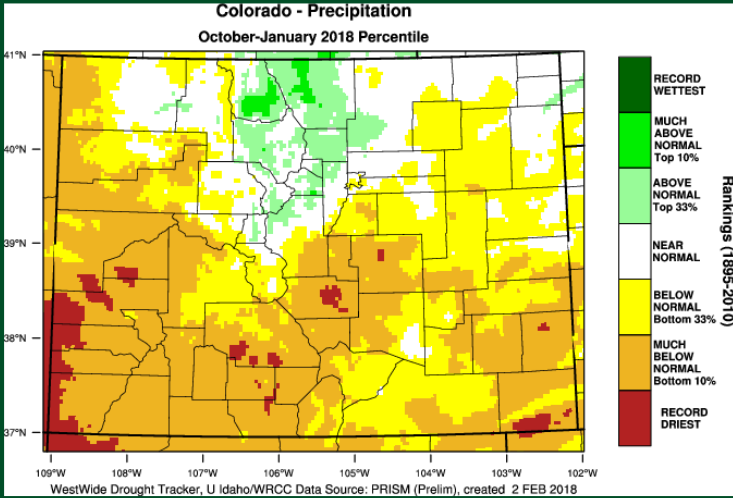
Mountain towns and ski resorts in Colorado are feeling the pinch of too little snow this season. However,with dry conditions prevailing into the summer, the impact to the state could play out in diverse ways.
“If dry conditions remain during the summer, some dryland crops will definitely be below average,” says Joel Schneekloth, regional water specialist. “If we don’t get adequate moisture to refill the soil surface, we may have a lot of acres that cannot be planted. Most of the fruit and vegetable crops in the state are grown with supplemental irrigation. Even with low snow pack, above average reservoir storage will probably offset low moisture for the 2018 growing season. Next year might be a different outlook if the current drought cycle continues.”
One outcome of a drought is increased likelihood of wildfires; preparing home and landowners for such conditions is crucial. Colorado State University Extension recently activated its Drought Response Task Force and has created an online portal for up-to-date drought resources.
Headed by Schneekloth and Reagan Waskom of the Colorado Water Institute and Colorado State University Extension, the task force is charged with updating all outreach materials that are made available to the diverse audiences impacted by drought. It was last convened during the 2012 drought.
Drought Fact Sheets
Drought planning resources
Kiowa County Extension
thekiowacountyextension.blogspot.com/
2018/01/drought-planning-resources.html
Live Smart Colorado Blog
livesmartcolorado.colostate.edu
Conditions vary throughout state
Conditions vary throughout the state, with Southwest Colorado, from Cortez east through the San Juan Mountains, feeling the most harmful effects of the drought. Range conditions are suffering and ranchers are being encouraged to reduce their herd size to match the carrying capacity of the land. Mountainous regions are also suffering; in the Salida area, Extension agent Kurt Jones describes the scene as “looking like June” in early February.
Extension agents and specialists share the latest research findings and forecasts regarding drought conditions with clientele throughout the state, through various outreach venues. They use traditional media, including local newspapers, and a variety of social media outlets, including Twitter, Facebook, and notification systems such as NextDoor.
Western Region range specialist Retta Bruegger is teaming up with USDA Climate Hubs personnel to put together drought planning workshops for the region. They have already presented in Farmington, New Mexico, and have two more workshops scheduled in Western Colorado later this month.
“We might have low surface soil moisture, but subsoil moisture is adequate in most of the state,” says Wilma Trujillo, area agronomist for Logan and Morgan Counties. “I have been using Twitter weekly to provide information on the weather and drought conditions from the USDA Drought Monitor and NRCS snow pack reports.”
In addition to these outreach activities by the Extension Water Team, Extension specialists with the Water Institute are very active in creating dialogue with water users and water managers regarding drought planning. This is done in a variety of ways:
- Participation in drought task forces
- Research projects that address drought stress and crop production
- Regular updates on drought conditions and changes for Master Gardener volunteers
- Participation as panelists in conferences/workshops to discuss drought conditions
- Outreach/education regarding climate smart agriculture, often in the form of drought planning and resiliency/adaptation.
- Collaboration with USDA Risk Management Agency on Crop Insurance issues for dryland and irrigated production.
Conduit of information
The water team is spread throughout the state, with specialists in each of Extension’s three regions. “We serve as a conduit of information between many drought-related research groups at different universities and Extension agents throughout the state,” says Blake Osborn, water resources specialist in the Peaks and Plains area. “We reach out to agents through webinars email, and personal conversation.”
Urban areas will be impacted by drought conditions as well, and horticultural specialists and agents are working with various groups to educate them. The Live Smart Colorado blog, produced by family and consumer science Extension agents, will be featuring vegetable gardening in drought conditions this spring. This topic has consequences for Coloradoans trying to garden for health and/or economic reasons.
“I am working with the Green Industry again to talk about Save Our Shade (campaign) if drought occurs,” says Jim Klett, Extension horticulturalist and CSU professor of horticulture, who added that The Garden Centers of Colorado are thinking of updating their educational campaign if a drought occur. “I am sure GreenCo will be working again with the water districts to get the message out.”